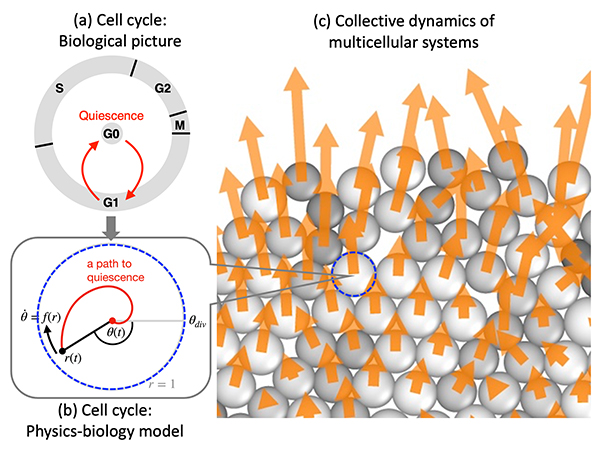The deepest goal of Physics is to understand how theories can be unified, e.g. gravity and quantum mechanics. What about Physics and Biology? When Physicists study cell colonies, like human tissue or a bacterial biofilm, they often view it as a kind of fluid and describe it in terms of the forces that drive cells to move within it. Cell biologists often start from the different perspective of the biochemical network inside a cell that is responsible for receiving signals and deciding whether a cell will grow, divide or die (Figure (a)). Forces are here seen as more like an input to the tiny chemical "computer" that is a cell.
An attempt to unify these viewpoints, published in Physical Review X, is the result of a collaboration between Kyoto University and Warwick University (UK), supported by JSPS. It presents a physics-based theory for growing cell colonies in which each element incorporates a simple version of the the regulatory network that controls cell growth and division, called the “cell cycle” (Figure (b)). This hybrid physics-biology theory is then used to predict how colonies develop. It explains why growth is fastest near the colony edge but also how cells far from the edge can behave very differently from normal fluids: they tend to be smaller, can actually be moving away from the growth front and can experience a pressure that is lower than elsewhere (Figure (c)). Similar effects have been observed in experiments on cells but have never been fully understood.
The new theory can now be extended to study, e.g. the invasion of cancer cells into healthy tissues or how embryos develop. The main hope is that this work will lead to more work in which biology and physics are better unified, so that both viewpoints are reflected in a consistent manner.
This work was supported by KAKENHI Grant No. 20H00129 and 20H05619. The UK-Japan collaboration was carried out under generous supports from JSPS and the Leverhulme Trust.

【DOI】https://doi.org/10.1103/PhysRevX.11.031025
【KURENAI ACCESS URL】http://hdl.handle.net/2433/264622
Jintao Li, Simon K. Schnyder, Matthew S. Turner, Ryoichi Yamamoto (2021). Role of the Cell Cycle in Collective Cell Dynamics. Physical Review X, 11(3):031025.





